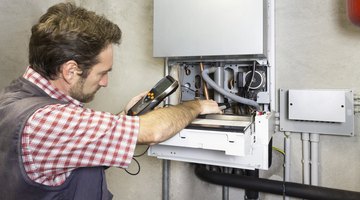How to Build a Steam Boiler
A steam boiler is a vessel that contains water and a heat source that turns the water into steam. The boiler transfers heat from the source to the water vessel, thereby creating steam.

This steam exits the vessel through a pipe and is transported to another location, where it can be used for cleaning, to power equipment, to provide heat or for a number of other functions. These instructions are for a basic steam boiler that can be used to provide heat to residential and small commercial buildings.
Things You Will Need
- Two copper base plates approximately 5 inches in length
- 4 8-inch metal bolts
- 4 6-inch metal Phillips-head screws
- Mechanical wrench
- Phillips-head screw driver
- Chemical pipe sealant
- Teflon tape
- Large pipe wrench
- 2 2-inch steel elbows
- 2 ¼-inch stainless steel reduces
- Rubber hosing 3 inches in diameter
- Bronze safety valve
- 2 4-inch pieces of stainless steel pipe
- Cast iron vessel and chimney
-
Order the appropriate boiler vessel and chimney. The vessel and chimney should be made of heavy duty cast iron and can be ordered from a metal foundry. The vessel and chimney should be made as separate parts and should arrive from the foundry as two different pieces.
-
Insert the T-pipe at the base of the chimney into the appropriate inlet valve on the side of the vessel. The diameter of the inlet valve will be slightly larger than the diameter of the T-pipe. Put some of the chemical pipe sealant on the outside of the chimney's T-pipe and push the chimney until the T-pipe has fully entered the vessel's inlet valve. You may have to rotate the chimney slightly as you push in order to get the T-pipe fully inserted.
-
Fully seal the T-pipe to the vessel's inlet valve by wrapping some of the Teflon tape around the attachment area.
-
Build the boiler's furnace. The copper base plates will be responsible for generating heat within the furnace. Insert the bolts into the threaded holes on the inside wall of the furnace compartment using the mechanical wrench, and hang the base plates on the bolts. Run the electrical cord from the base plates to the outside of the vessel where it can be plugged into an electrical outlet.
-
Assemble the drain. Apply some chemical pipe sealant to the threaded part of the steel reducer and screw the steel reducers to the bottom of the boiler vessel using the pipe wrench. Seal the reducer in place using the Teflon tape. Use the pipe wrench to screw the steel elbow to the reducer, and then screw one piece of the 4-inch stainless steel pipe to the elbow using your hands. Seal all attachments using the chemical sealant on the threads and the Teflon tape on the outside of the attachment areas. Finally, screw the 5-inch copper tubing into the stainless steel pipe using your hands, and seal the attachment area. The tubing will carry excess water from the boiler, so the other end of the tubing must attach to an outlet pipe or end in a place where the excess water can be released.
-
Attach the bronze safety valve to the top of the boiler's vessel using the metal screws and the Phillips-head screw driver. You can purchase a safety valve from an industrial supply company such as WW Grainger.
-
Apply chemical sealant to the threads of the second steel reducer, and use the pipe wrench to screw the reducer into the valve at the top of the vessel's dome. Seal the attachment with the Teflon tape, and screw the second elbow to the reducer using the pipe wrench. Next, screw one end of the second 4-inch piece of stainless steel pipe into the reducer and attach the other end to the building's main heating line. The pipe will transport the steam from the furnace to the heating line, which will distribute it to the building's radiators. Be sure to seal all attachments with the chemical sealant and the Teflon tape.
-
Screw the rubber hosing into the bottom outlet on the boiler's vessel using your hands, and seal the attachment with the chemical sealant and the Teflon tape. Run the hose from the furnace to the furnace's water supply.
Tip
Be sure to locate the furnace near an electrical outlet that can provide power to the copper base plates. The length of the rubber hose that you will need will depend upon the distance between the boiler and the water source. Make sure you purchase enough hose to be able to reach the furnace's water supply.
Warning
Make sure that you assemble the furnace in a well-ventilated area. Furnaces are often located in basements and other poorly ventilated locations. However, the pipe thread sealant is toxic and gives off poisonous fumes. Use a fan to improve air circulation if the ventilation is poor. Always wear safety goggles as well as long pants and close-toed shoes when working with heavy pieces of metal.
Resources
Writer Bio
This article was written by the CareerTrend team, copy edited and fact checked through a multi-point auditing system, in efforts to ensure our readers only receive the best information. To submit your questions or ideas, or to simply learn more about CareerTrend, contact us [here](http://careertrend.com/about-us).
More Articles


